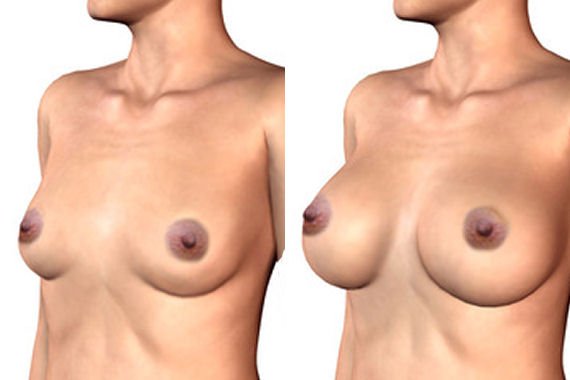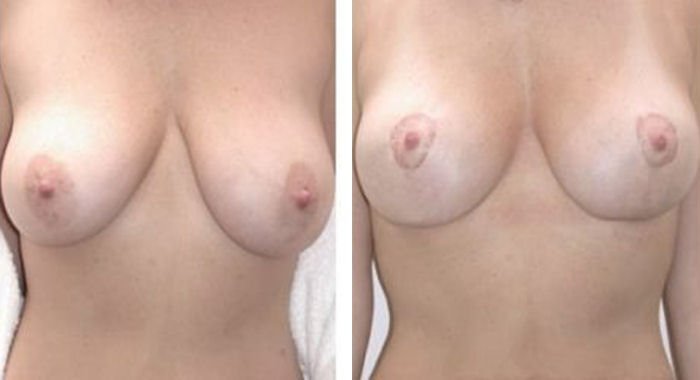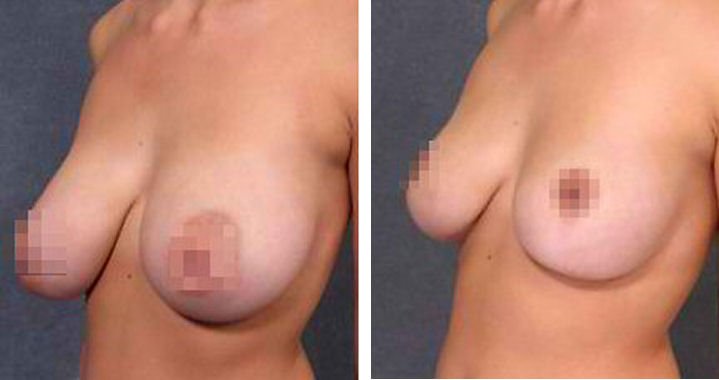Breast Surgery
Our 3 Most Popular Breast Procedures
Breast size, symmetry and contour directly affects a woman's self confidence and sex appeal. Maybe that's why these surgical corrections are some of our most requested.
Breast Augmentation
Breast augmentation is a surgical procedure aimed at increasing breast size using implanted prostheses. In addition to increasing volume, it can also create a more rounded appearance and improve breast symmetry. It is the world’s most popular cosmetic procedure because there are deep and powerful psychological incentives to improving breast size and shape. When a cosmetic surgeon visually enhances a woman’s breasts, the resulting rise to her sexual attractiveness and self-confidence can be life-changing.Implant Options
There are two main types of implants used for breast augmentation.1. Saline breast implants:
This implant contains sterile saline water. Saline implants are placed in position empty and are filled with a predetermined amount of fluid after placement. Modern saline implants have a flexible volume that can be adjusted during placement, or with some implant manufacturers, up to 6 months after the procedure. Once the fill-tube is removed, the implants close using a self-sealing valve. Saline implants have some advantages. For example, because they are filled after placement, they can be inserted via an underarm or navel incision, which minimizes scarring. Also, in case of leaks or rupture, implant contents are rapidly absorbed and expelled from the body.2. Silicone breast implants
These implants, available in both round or anatomical (teardrop) shape, are filled with a cohesive silicone gel that simulates the feel of human fat and provides a more natural tactile experience. Our most popular implants use a multi-layered silicone shell covered with thin micropolyurethane foam. Technology developments in this area include breast implants using lighter materials that offer more patient comfort at larger sizes. Another new variant is form-stable implants which contains a gel thicker than traditional breast implants, and which will maintain shape even if the shell is broken. Round vs anatomical (teardrop) shaped implants The most important decision the breast augmentation patient will face (after size) is whether to use round or anatomically shaped implants.Round Implants
Round implants, as the name suggests, are circular in shape. It would however be incorrect to assume they cannot offer the augmentation patient a natural look. While round implants make the breasts look slightly more fuller above the nipple line, a quite natural contour can be achieved if the implant is sized properly, and is in proportion to body shape and existing breast tissues. And unlike a teardrop implant, since a round implant has a symmetrical shape, there is no chance of a future asymmetry caused by accidental rotation.Teardrop Implants
Teardrop implants on the other hand are asymmetrically shaped to simulate a breast’s anatomic form. The added bulk at the bottom of these type implants make the breasts appear fuller below the nipple line. This is consistent with female anatomy and makes the augmentation more difficult to detect. Teardrop implants are most often used with slender or athletic patients, when existing tissue coverage is thin. Patients should be aware that anatomical implants are slightly more expensive than round implants.Breast augmentation surgery
Breast augmentation surgery usually lasts 2 to 3 hours and is performed under general anesthesia. First the surgeon will measure and mark the breasts. During the procedure, the surgeon makes an incision under the breast or the areolar tissue. In some cases, the incision may made at the armpit or navel.Then a pocket is created, either between the breast tissues and the pectoralis muscle, or under the muscle fascia, into which the implants are placed. Once the implant is properly positioned, incisions are sutured.
The chest is then wrapped in a gauze dressing with elastic bandage. A support bra (compression garment) will also be used to minimize the swelling and provide support to the breasts during the healing phase. After surgery the patient remains in clinic for 1 or 2 nights.
Attention should be given to placement of the breast implant relative to chest musculature, the two alternatives being:
1. Subglandular: insertion between the pectoralis muscle and the breast tissue. This form of placement offers higher level of aesthetic improvement but does slightly increase the risk of capsular contracture.
2. Submuscular: Under muscle placement has the advantage of reduced risk of implant rippling and better implant support, which reduces the strain on breast tissues. However, women who have undergone a submuscular implant placement usually have a longer recovery period and experience slightly more temporary discomfort. Incision placement.
One of the concerns patients have about breast augmentation surgery is the issue of scar visibility. The 3 most popular incisions are:
1. Inframammary: This is a incision made below the breast at the inframammary fold. Although it may leave a relatively long (but concealed) scar it is much preferred by surgeons as it offers a wider access aperture.
2. Periareolar: This incision is placed along the border of the areola. The scar from this incision is usually not so visible as it is placed along the medial or inner half of the areola.
3. Transaxillary: This incision is placed in the armpit and is used to avoid leaving a visible scar on breasts. However, this incision may contribute to some minor breast asymmetry.
What can patients expect after breast augmentation surgery?
Most women recover rapidly and resume most routine activities within 1 or 2 weeks. However, patients can expect some mild soreness and swelling for 3 to 4 weeks post-op.
Strenuous exercise is not advised until all incisions have fully healed and breast tissues are settled and stabilized, which can be expected after 6+ weeks.
It should be noted that breast implants do not last indefinitely and may eventually need to be replaced. Therefore, it’s a good idea to meet your surgeon every couple years to evaluate implant integrity and breast health.

Breast Lift – Mastopexy
Breast Lift or Mastopexy is a procedure to correct the problems of breast droop, deflation, and volume reduction. The most common causes of these problems are ageing, pregnancy, and weight loss. A consistent factor among all causes is a loss of collagen, which degrades breast tissue elasticity. Typical patients are older women ages 35-60 who often combine an augmentation with their breast lift as a way to maximize body contour rejuvenation.The Breast Lift Procedure
The procedure involves either partial or circumferential incisions of breast tissues usually with the nipple repositioned to create a proper asthetic result. A standard mastopexy will use only the patient’s own breast tissues and does not involve any fat transfer. The surgical challenge arises with the choice of incision as the surgeon must consider several factors such as areola position, skin elasticity and if an implant will be utilized. The most popular variants are:1. Circumareolar Mastopexy: also known as a doughnut breast uplift, it involves an incision around the nipple and is often used for correcting mild and modest breast ptosis.
2. Circumvertical Mastopexy: This is also known as Lollipop Breast Lift. It is a modification of the cirmcumareolar in which incision is made both around the areola and vertically downward.
3. Wise-Pattern Mastopexy: The wise pattern mastopexy is for correcting the most severe breast drooping. It involves incisions which are done around the areola, a vertical line, as well as a horizontal crease.
Recovery After Breast Mastopexy
The recovery process of breast mastopexy begins with the removal of sutures a few days after surgery. Patients will be required to wear a compression garment for about 2-3 weeks post-op. Full recovery will probably require a bit over 2 months.
Breast Reduction
Female Breast Reduction
Breast reduction surgery, also known as reduction mammoplasty, is used to reduce breast volume and weight by removal of excess tissue. It is indicated for patients with disproportionate breast size when accompanied by problems such as poor self-image due to large breasts, chronic back or neck pain, under-breast rashes or activity restrictions. There are four procedures to reduce breast size. Two most common surgical techniques used for breast reduction surgery are:
Inverted-T or Anchor Breast Reduction:
This technique involves three incisions, one around the perimeter of the areola, one that extends vertically from the areola to the breast crease, and one that follows the crease under the breast.Short Scar or Lollipop Breast Reduction:
This technique consists of an incision around the nipple/areola area and one that extends down vertically from the bottom of the areola to the crease below the breast.Two other less common techniques which your doctor may suggest are: Vertical-Pattern Reduction and Circumareolar Reduction.
All procedures also include adjusting remaining breast tissue structure, re-aligning and tightening to give the breasts their new shape and contour, as well as re-positioning the patient’s breasts to appear proportionate with the patient’s body. Recovery period is around 2-4 weeks.
Male Breast Reduction
Male breast reduction surgery (gynomastia surgery) is a method used to remove excess glandular tissue from a male chest. The goal is to restore the appearance of a flatter and more normal looking male chest.
Patient desire for this surgery is driven primarily by negatve psychological affects, which include low self-esteem, low self-confidence, and a negative body image, all with their associated behavioral inhibitions.
The problem can affect men of all ages but appears most prevalent in middle age. Distortions in male breast tissue volume can sometimes occur asymmetrically.
The procedure itself is bit simpler than female reduction because there is less excess fat and tissue to remove. Liposuction is often included, however lipo alone cannot achieve the intended goal.
Scarring is minimal and fades quickly. Recovery period is 3-7 days, with pressure garments required during that time. Strenuous activity is to be avoided for 2-3 weeks; swelling and bruising may last a few months.

